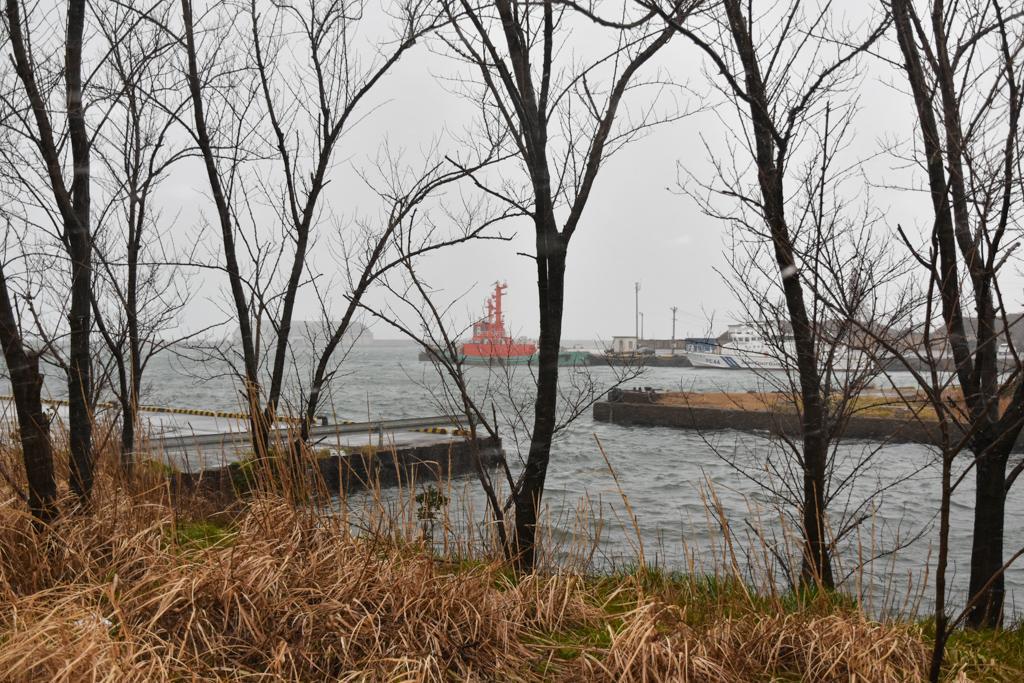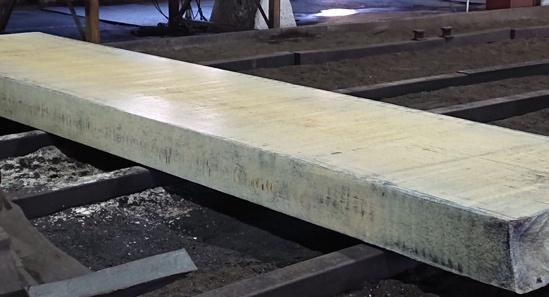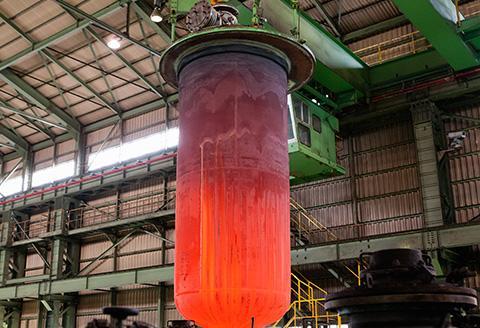As reported in the previous articles, PIGMENT TOKYO launched the world's first painting substrate, TranTixxii® designing Titanium Panel with Nippon Steel Corporation, which pursues the world's finest technology and manufacturing.
Color Titanium Panels
In the production of this TranTixxii® series, Designing Titanium Plates requires various processes such as refining and casting raw materials, polishsing, and other special final surface treatments.
Most of these processes are implemented by Nippon Steel Corporation Naoetsu Works in Joetsu City, Niigata Prefecture. This area is located in the center of the Hokuriku region and has been one of the major transportation hubs since ancient times. This area is also famous for historical figures such as Kenshin Uesugi.

Nippon Steel CorporationNaoetsu Works (front view)

Right next to the factory is the Japan Sea as the snow is blowing sideways by the sea wind!
This is such a special opportunity for us to visit the manufacturing plant that is located in a region with heavy snowfall to learn more about the manufacturing process of the TranTixxii®.It seems to be the first time to have a camera shooting around the factory. Therefore, without further ado, let's take the wraps off and have a closer look at the hidden secrets in titanium.
First of all, Mr. Kazuhiro Arai, Senior Manager, Head of Department Quality Management Dept., Quality Management Div. Naoetsu WOrks, Titanium Unit, gave me an overview of the titanium production process.

Designing Titanium Plates, we are carrying at PIGMENT TOKYO is manufactured through the following process.
Step ①Extraction
Extracts titanium metal content from titanium sands to produce a granular mass (titanium sponge).
Step ② Dissolution
Melts the sponge titanium to produce a huge mass of titanium (ingot).
Step ③ Separation
Separates the lumps by forging ingots and shapes them into rectangular slabs for the next process.
Step ④ Hot Rolling
Titanium is softened under a high heat and stretched out underpressure to form a thin titanium sheet in the form of a roll (like a roll of toilet paper).
Step ⑤ Cold Rolling
Stretches out the titanium sheet under room temperature to produce a thinner and finer rolled titanium sheet.
Step ⑥ Design
Develops colors on titanium with oxide coating, and creates textures on the surface by special processing.
These processes are not operated in a single factory and are shared with other Nippon Steel Corporation’s manufacturing plants and affiliated companies throughout Japan. The high quality products are produced by their close communication among the factories.
The core hub Naoetsu Area is responsible for the primary processes ②, ③, and ⑤, and operates as a control tower for factories outside the area regarding the processes ①, ④, and ⑥.
Let's take a look inside the factory where the titanium is manufactured.
First thing I sawin the factory is step ① drums filled with titanium sponges that have undergone the extraction process. The fresh titanium sponges (before making into pebble shapes ) have random forms like foam or abstract sculptures.

A lot of titanium sponges are contained in these drums.

An image of a titanium sponge (photo provided by Toho Titanium Co., Ltd.)
The titanium sponges in the drums are crushed into small pieces and then ② hardened into a form suitable for the dissolution process. As a result, a huge cluster of titanium sponge grains (called crop) are created.

Titanium sponge grains

A crop, a group of huge titanium sponge grains (image)

The surface of the crop before melting in the furnace. It has a glossy and massive texture.
Then, the crop is put into a large electric furnace. A cylindrical lump of titanium called an ingot is formed by fusing.
Photo during the dissolution (Courtesy of Toho Titanium Co., Ltd.)

Titanium ingot after the dissolution.
The surface of the ingot
This method is also applied to develop the colors of TranTixxi®.
Next, the ingot goes to step ③, separation. In the process, it is forged ( hammered and deformed) by a machine before being thinned and stretched in step ④. The approximately 1.5m diameter cylinder slab is deformed into an approximately 30 cm thick rectangular piece.

After the cooling process is complete , ④ the slab is sent to the other manufacturing plant for the hot rolling process.
Once the steel has passed through the gigantic hot-rolling process at the steel mill, it is returned to the Naoetsu factory in the form of rolls,
and it continues to step ⑤ which is the cold rolling process.

Hot rolling process

Coil after the hot rolling process
The cold rolling process uses huge rollers to stretch out the rolled titanium sheets over and over at room temperature until it reaches the ideal thickness for each client.
There are twenty rollers combined in total at the top and bottom. The thickness of the titanium plates we carry at PIGMENT TOKYO is 0.3 mm.
Lastly, TranTixxii® is completed with a special surface treatment to adjust the color and texture in the ⑥ design process .
This time, Mr. Sousuke Nishiwaki and Mr. Kohei Fujita from the technical department in the Naoetsu Area showed us the color samples of the Designing Titanium Plates.
They have been involved in the planning and researching of the series and have created it through continuous experimentations.

From left to right: Mr. Sosuke Nishiwaki, Manager of Production & Technical Control Dept. Production Div. Naoetsu Works, TItanium Unit, and Mr. Kohei Fujita from the same unit.
I was genuinely overwhelmed by the wide range of variations and expressions of titanium created by different manufacturing processes and secret recipes. It is truly the result of our accumulated experiences. Its delicate color gradation and the complex textures are hard to believe that they are all the same material, titanium.
During my visit to Nippon Steel Corporation Naoetsu Area, I learned that many people have been involved in the titanium production project., The world-class Designing Titanium Plate, TranTixxii®, is manufactured with great care in Naoetsu, the hub of the world's most advanced technology and manufacturing, and it will open a door for your creativity as a new painting substrate!
Corporate Information
Nippon Steel Corporation Head Office
Marunouchi Park Building, 6-1, Marunouchi 2-chome, Chiyoda-ku, Tokyo, Japan
TEL: 03-6867-4111
FAX: 03-6867-5607
https://www.nipponsteel.com/en
Designing Titanium TranTixxii® series website
https://www.nipponsteel.com/en/product/trantixxii/
Naoetsu Area, East Japan Works, Nippon Steel Corporation
2-12-1, Minato-cho, Joetsu City, Niigata Prefecture
Source Material Provided by
Toho Titanium Co.,Ltd.
3-3-5 Chigasaki, Chigasaki-shi, Kanagawa
TEL: +81-467-87-2830
https://www.toho-titanium.co.jp/enTranslated by Atsumi Okano, Nelson Hor Ee Herng
PIGMENT TOKYO Art Materials Experts





